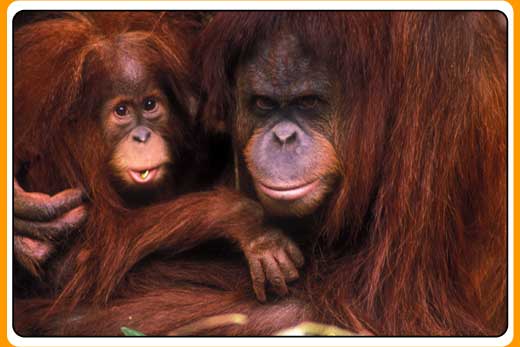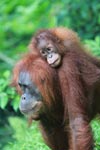ORANGUTANS by: Kaitlin and Nichelle
CLASSIFICATION GENERAL INFO SPECIAL FEATURES HABITAT DIET REPRODUCTION BODY SYSTEMS HUMAN IMPACT WEBLINKS SOURCES

Kingdom: Animalia
Phylum: Chordata
Class: Mammalia
Order: Primates
Family: Pongidae
Genus species: Pongo pygmaeus
Orangutans have no tail and have very long arms. They can live
for over 60 years and are extremely intelligent like humans and other
primates.
Male orangutans establish home ranges that embrace those of several females. Females reach maturity at around ten years and can remain fertile for more than 30 years. On average, wild females give birth only every eight years. Young orangutans nurse up until they are age six, and stay close to their mothers until the next offspring comes along. Mothers only have about two or three children in their lifetime.
They are the largest Asia primates. The males stand about four and a half feet tall and can weigh up to 300lbs. Females are only half as big as males. They are the largest tree-dwelling animal. At night, they bend branches into nest platforms to support themselves while they sleep.
GROWING UP AS AN ORANGUTAN
When a baby orangutan is born, it is extremely helpless much like a human baby. They can't walk and need constant care from the mother. Orangutans stay with their mother until they are around eight years old. In this time the mother teaches the child to walk and what food is good to eat. She also teaches it what areas of the rainforest to stay out of. After the orangutan leaves the mother it takes another five to six years to fully mature.
ORANGUTANS IN THE WILD VIDEOS:
1.) http://www.globio.org/glossopedia/videopopup.aspx?gls _
video_title=Orangutan+love&gls_file_nm=000225m1.flv
2.)http://www.globio.org/glossopedia/videopopup.aspx?gls_video_tit
le=Using+tool+to+get+food&gls_file_nm=000033m1.flv
3.)http://www.globio.org/glossopedia/videopopup.aspx?gls_
video_title=Orangutan+eating+lettuce&gls_file_nm=000230m1.flv

Orangutans live in the tropical rainforests, including both hill forests and swamp forests. They are only found in the southeast islands of Asia in Sumatra and Borneo.
DIET:
Orangutans are omnivores but primarily herbivores. Their digestive
system is set up more like a carnivore though so it's inefficient.
Because of this they need to eat a huge amount of food everyday,
sometimes up to 12kg. To find all of this food, they spend about 6 to
8 hours everyday finding food. They eat mostly
fruits but occasionally eat insects or small animals. They store food
in their mouths so they have free hands but don't lose the food. Geophagy has
also been observed, which is the practice of eating soil and rocks.
Orangutans are endangered. On of the primary
reasons is because their habitats are being destroyed so we can put
palm oil in our food. Man made fires are also destroying the forests
they call home. There are only 70,000 orangutans left in the world. If
nothing is done to prevent their extinction they will be gone within
the next 10 years.
Orangutan Quiz: http://www.sheppardsoftware.com/content /animals/quizzes/mammals/OrangutanGame_1.html
SAVE THE ORANGUTAN! Help save this dying population by adopting or donating to the cause! See this website for more info: http://www.savetheorangutan.org.uk/

